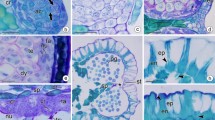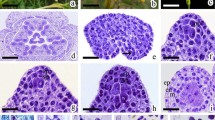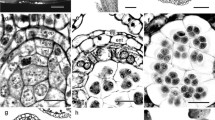Abstract
Forsythia saxatilis, a Korean native Forsythia, is recognized as an endangered species in the Korean Red List. We carried out a comprehensive embryological investigation, including a study of the pericarp development, of F. saxatilis and compared it with previously acquired information on the family Oleaceae and also with Abeliophyllum distichum, a close relative of Forsythia. Our results revealed that several embryological features of Forsythia are exclusively comparable with the family Oleaceae, particularly in relation to A. distichum. Despite the differences in fruit types and pericarp ontogeny, Forsythia shares some unique embryological features with Abeliophyllum, for instance the basic type of anther wall development, formation of the nucellar cap, a long micropyle, formation of the obturator and hypostase, and the crushed endotesta. Furthermore, the loculicidal capsule of Forsythia seems to be primitive within the tribe Forsythieae and samara of Abeliophyllum might be evolved from it. In conclusion, a considerable number of synapomorphies of embryological characters supports recent molecular reports and provide additional embryological evidence for the sister-group relationship of Forsythia and Abeliophyllum.





Similar content being viewed by others
Change history
27 August 2020
In the original publication of the article, species name.
References
Albach D, Soltis PS, Soltis DE (2001) Patterns of embryological and biochemical evolution in the asterids. Syst Bot 26:242–262
Anderson F (1931) Studien uber der embryologie der familien Celastraceae, Oleaceae und Apocynaceae. Acta Univ Lund 27:1–112
Bhargava YR (1980) Microsporogenesis and male gametophyte in Jasminum pubescens Wild. Curr Sci 49:911–912
Corner EJH (1976) The seeds of dicotyledons, vol 1. Cambridge University Press, Cambridge
Davis GL (1966) Systematic embryology of angiosperms. Wiley, New York
de Olivera Franca R, De-Paula OC (2017) Embryology of Pera (Peraceae, Malpighiales): systematics and evolutionary implications. J Plant Res 130:709–721
Endress PK (2011) Angiosperm ovules: diversity, development, evolution. Ann Bot 107:1465–1489. https://doi.org/10.1093/aob/mcr120
Filonenko A (2008) Fruit structure and pericarp anatomy of ash species (Fraxinus L., Oleaceae). Poster abstract Botany 2008, Abstract ID: 262
Filonenko AB, Efremov AH (2011) The morphology and anatomy of Menodora (Oleaceae) genus fruit. Tomsk State Univ J Biol 2:16–21
Ghimire B, Heo K (2014) Embryology of Abeliophyllum (Oleaceae) and its phylogenetic relationships. Nord J Bot 32:632–641
Ghimire B, Jeong MJ, Choi GE, Lee H, Lee KM, Lee CH, Suh GK (2015) Embryo, seed coat and pericarp development in Abeliophyllum distichum Nakai (Oleaceae): a rare and endemic plant of Korea. Korean J Plant Res 28:350–356
Ha YH, Kim C, Choi K, Kim JH (2018) Molecular phylogeny and dating of Forsythieae (Oleaceae) provide insight into the Miocene history of Eurasian temperate shrubs. Front Plant Sci 9:99
Herr JM Jr (1984) Embryology of angiosperms. Springer, Berlin
Hong SP, Han MJ (2002) The floral dimorphism in rare endemic plant, Abeliophyllum distichum Nakai (Oleaceae). Flora 197:317–325
Jedrzejuk A, Szachetka W (2005) Development of flower organs in common lilac (Syringa vulgaris L.) cv. Mme Florent Stepman. Acta biologica Carcovensia, Series Bot 47:41–52
Jensen SR, Franzyk H, Wallander E (2002) Chemotaxonomy of the Oleaceae: iridoids as taxonomic markers. Phytochemistry 60:213–231
Johnson LAS (1957) A review of family Oleaceae. Contrib NSW Natl Herb 2:395–418
Johri BM, Ambegaokar KB, Srivastava PS (1992) Comparative embryology of angiosperms, vol 2. Springer, Berlin
Kapil RN, Vani RS (1966) Nyctanthes arbor-tristis Linn: embryology and relationships. Phytomorphology 16:553–563
Kaveh M, Tavassoli A, Memariani F, Azadi R (2015) New report on anatomy of lenticel development in Fraxinus (Oleaceae) species from Iran. Acta Biologica Szegediensis 59:103–108
Kim KJ (1999) Molecular phylogeny of Forsythia (Oleaceae) based on chloroplast DNA variation. Plant Syst Evol 218:113–123
Kim DK, Kim JH (2011) Molecular phylogeny of tribe Forsythieae (Oleaceae) based on nuclear ribosomal DNA internal transcribed spacers and plastid DNA trnL-F and matK gene sequences. J Plant Res 124:339–347
Kim KJ, Lee HL, Kim YD (2000) Phylogenetic position of Abeliophyllum (Oleaceae) based on nuclear ITS sequence data. Korean J Plant Taxon 30:235–250 (In Korean with English abstract)
Kim HS, Cho SH, Yoon HS, Jeon J, Kim SC (2018) Characterization of the complete chloroplast genome of Forsythia saxatilis (Oleaceae), a vulnerable calcicolus species endemic to Korea. Conserv Genet Resour 10:723–726
Lakshminarayana K (1978) Embryology of Jasminum pubescens Willd. In: Proceedings of 65th Indian Science Congress, Ahmedabad, p 85 (Abstract)
Lee S, Park EJ (1982a) Cladistic analysis of the Korean Oleaceae. Korean J Plant Taxon 25:57–64
Lee S, Park EJ (1982b) A palynotaxonomic study of the Korean Oleaceae. Korean J Plant Taxon 12:1–11
Lee HL, Jansen RK, ChumleyTW Kim KJ (2007) Gene relocations within chloroplast genomes of Jasminum and Menodora (Oleaceae) are due to multiple, overlapping inversions. Mol Biol Evol 24:1161–1180
Li J, Alexander JH, Zhang D (2002) Paraphyletic Syringa (Oleaceae): evidence from sequence of nuclear ribosomal DNA ITS and ETS region. Syst Bot 27:592–597
Maheshwari P (ed) (1963) Recent advances in the embryology of angiosperms. International Society Plant Morphologists University, Delhi
Maheshwari DH (1975) Embryology of Jasminum and its bearing on the composition of Oleaceae. Acta Bot Indica 3:52–61
Maheshwari P, Kapil RN (1966) Some Indian contributions to the embryology of angiosperms. Phytomorphology 16:239–291
Mathews S, Donoghue MJ (1999) The root of angiosperm phylogeny inferred from duplicate phytochrome genes. Science 286:947–950
Messeri A (1952) Aluni dati sulla embriologia ed embriogenesi di Olea europia L. Nuovo. G Bot Ital 57:149–169
Nakai T (1919) Abeliophyllum distichum. Bot Mag 33:153–154
Palser BF (1975) The base of angiosperms phylogeny: embryology. Ann MO Bot Gard 62:621–646
Rohwer JG (1993) A preliminary survey of the fruits and seeds of the Oleaceae. Bot Jahrb Syst 115:271–291
Rohwer JG (1994) Seed characters in Jasminum (Oleaceae): unexpected support for DE CANDOLLE’S sections. Bot Jahrb Syst 116:299–319
Rohwer JG (1995) Fruit and seed structures in Menodora (Oleaceae): a comparison with Jasminum. Bot Acta 108:163–168
Rohwer JG (1996) Die frucht- und samenstrukturen der Oleaceae. Bibliotheca Botanica 148:1–177
Rohwer JG (1997) The fruits of Nyctanthes aculeate (Oleaceae). Bot Jahrb Syst 119:293–299
Rudall PJ, Remizowa MV, Beer AS, Bradshaw E, Stevenson DW, Macfarlane TD, Tuckett RE, Yadav SR, Sokoloff DD (2008) Comparative ovule and megagametophyte development in Hydatellaceae and water lilies reveal a mosaic of features among the earliest angiosperms. Ann Bot 101:941–956
Sax K, Abbe EC (1932) Chromosome numbers and anatomy of the secondary xylem in the Oleaceae. J Arnold Arb 13:37–47
Soltis PS, Soltis DE, Chase MW (1999) Angiosperm phylogeny inferred from multiple genes as a tool for comparative biology. Nature 402:402–404
Song JH, Hong SP (2012) Comparative anatomy of petiole in Forsythieae, Fontanesieae and Myxopyrum (Oleaceae) and its systematic implication. Korean J Plant Taxon 42:50–63
Soueges R (1942) Embryogenie des Oleacees. Developpment de l’embryon chez le Ligustrum ovalifolium Hassk. Acad Sci Paris 215:328–330
Suh Y, Kim YJ (2012) Korean red list of threatened species: mammals, birds, reptiles, amphibians, fishes and vascular plants, 2nd edn. National Institute of Biological Resources, Incheon
Tae KH, Kim DK, Kim JH (2005) Genetic variations and phylogenetic relationships of tribe Forsythieae (Oleaceae) based on RAPD analysis. Korean J Plant Res 8:135–144
Taylor H (1945) Cytotaxonomy and phylogeny of Oleaceae. Brittonia 5:337–369
Tobe H (1989) The embryology of angiosperms, its broad application to the systematic and evolutionary study. Bot Mag (Tokyo) 102:351–367
Tobe H (2015) Embryology of Phyllonoma (Phyllonomaceae, Aquifoliales): characteristics and character evolution. J Plant Res 128:633–642
Tobe H, Kadokawa T (2010) Endosperm development in the Araceae (Alismatales) and evolution of developmental modes in monocots. J Plant Res 123:731–739
Tobe H, Raven PH (2008) Embryology of Koeberlinia (Koeberliniaceae): evidence for core brassicalean affinities. Am J Bot 95:1475–1486
Tobe H, Raven PH (2010) Embryology of Irvingiaceae, a family with uncertain relationships among Malpighiales. J Plant Res 124:577–591
Tobe H, Takahashi H (2009) Embryology of Petrosavia (Petrosaviaceae, Petrosaviales): evidence for the distinctness of the family from other monocots. J Plant Res 122:597–610
Tobe H, Jaffre T, Ravan PH (2000) Embryology of Amborella (Amborellaceae): descriptions and polarity of character states. J Plant Res 113:271–280
Wallander E, Albert VA (2000) Phylogeny and classification of Oleaceae based on rps16 and trnA-F sequence data. Am J Bot 87:1827–1841
Yamamoto T, Vassiliades D, Tobe H (2014) Embryology of Biebersteinia (Biebersteiniaceae, Sapindales): characteristics and comparisons with related families. J Plant Res 127:599–615
Yamamoto T, Fijridiyanto IA, Tobe H (2016) Embryology of Harrisonia (Cneoroideae, Rutaceae): a comparison with related genera and families. Bot J Linn Soc 180:386–400
Zhang JT (1982) Study on the pollen morphology of Chinese family Oleaceae. Acta Bot Sin 24:499–505
Acknowledgements
This study was financially supported by the project ‘Ex-situ Conservation of Forest Plant Seeds in Korea (KNA1-2-29). We are thankful to two anonymous reviewers for their insightful comments and suggestions on a previous version of this manuscript.
Author information
Authors and Affiliations
Corresponding author
Additional information
Publisher's Note
Springer Nature remains neutral with regard to jurisdictional claims in published maps and institutional affiliations.
Rights and permissions
About this article
Cite this article
Ghimire, B., Yum, D., Kim, J.H. et al. The embryological insight into the relationship between Forsythia and Abeliophyllum (Forsythieae, Oleaceae). J Plant Res 133, 611–623 (2020). https://doi.org/10.1007/s10265-020-01218-8
Received:
Accepted:
Published:
Issue Date:
DOI: https://doi.org/10.1007/s10265-020-01218-8




